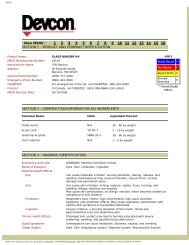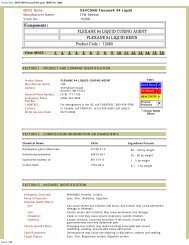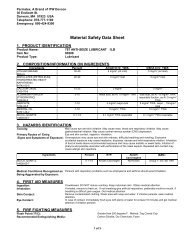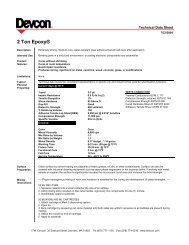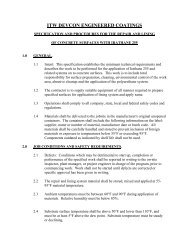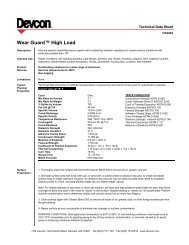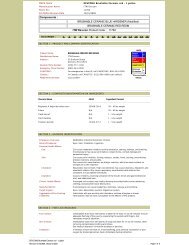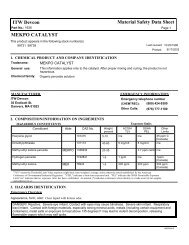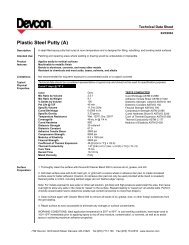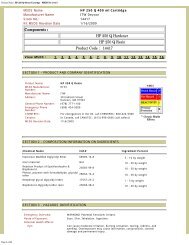You also want an ePaper? Increase the reach of your titles
YUMPU automatically turns print PDFs into web optimized ePapers that Google loves.
Concrete<br />
To properly prepare a concrete surface:<br />
1) Degrease the surface with <strong>Devcon</strong> Cleaner<br />
Blend 300 or any water-based emulsifying<br />
cleaner and rinse thoroughly. Multiple<br />
cleanings may be necessary. Power washers<br />
or steam cleaners are very effective and can<br />
reduce the number of passes needed to clean<br />
the surface. Let the surface dry thoroughly<br />
before proceeding.<br />
2) Remove any cap-curing agents that were<br />
applied to the concrete when it was poured.<br />
These agents form a dense, impenetrable<br />
finish, making it almost impossible for coatings<br />
to adhere to them.<br />
3) Shot blast (Blastrac ® ) the concrete to create<br />
a porous surface profile. This will improve<br />
surface “wetting” and coating or repair<br />
product adhesion.<br />
<strong>Devcon</strong> Technical Service:<br />
If you have questions, please contact<br />
<strong>Devcon</strong> Technical Service:<br />
1-800-933-8266<br />
Blastrac ® is a registered trademark of Blastrac, NA.<br />
SURFACE PREPARATION<br />
Wet Surfaces<br />
In general, <strong>Devcon</strong> repair products and protective<br />
coatings will not adhere to wet surfaces.<br />
To properly repair a wet surface:<br />
1) Review the General Surface Preparation guidelines.<br />
2) Thoroughly dry the surface. (If you are using<br />
<strong>Devcon</strong> Underwater Repair Putty (UW), refer to<br />
Underwater Surfaces section.)<br />
3) Stop all leaks or seepage as follows:<br />
t Shut off the flow or pressure;<br />
t Fit a wooden peg or a sheet metal screw into<br />
the hole; or<br />
t Stuff wax, cork, plumber’s caulk, Mortite or<br />
a cloth into the opening.<br />
If the leak is caused by corrosion, the sidewall<br />
might be weak. Open the orifice until sound<br />
metal is exposed and the wall is thick enough<br />
to be plugged.<br />
4) Remove surface condensation (sweating) or<br />
dampness with a heat gun or similar device.<br />
SURFACE PREPARATION<br />
Underwater Surfaces<br />
To properly prepare an underwater surface:<br />
1) Remove all dirt, barnacles, flaking paint or<br />
algae/seaweed from the surface.<br />
2) Wipe the surface with a clean cloth to remove<br />
any film. Although you cannot degrease<br />
underwater, wiping and turning a clean cloth<br />
will often remove any film from the surface.<br />
3) Abrade the surface if possible. (Use a file or<br />
other mechanical means.)<br />
4) Remove oxidation by mechanical means such<br />
as high-pressure water or grit-blasting, or by<br />
chemical means such as acid etching.<br />
7



